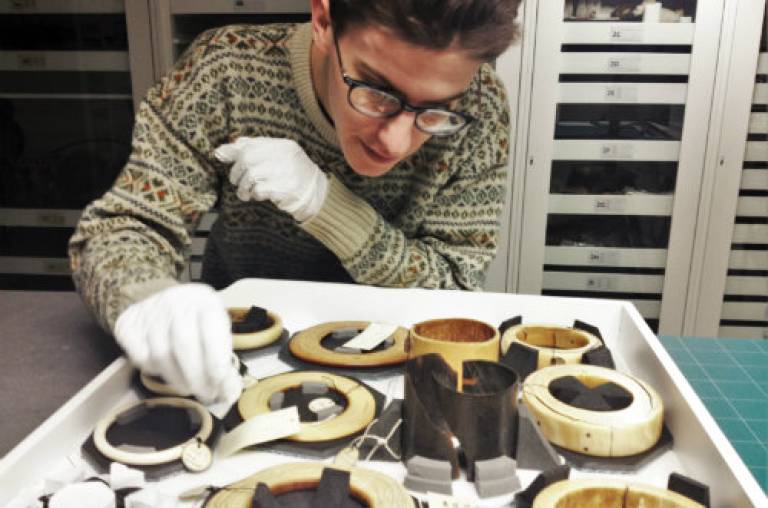Working with teaching collections: Students as assistant curators
Dr Haidy Geismar explains how students in the Anthropology department have access to a unique ethnographic collection and are gaining professional museum experience as part-time curators.

9 May 2016
With around 2250 artefacts, undergraduate and graduate students use the UCL Ethnography Collections to learn about issues of:
- material culture
- cultural heritage
- cultural representation
- conservation
- and curatorship.
The collections represents the areas of art, technology and material culture from across the world, with material from every continent.
This diverse and striking collection has weaponry, textiles, basketry, musical instruments, and traditional medicinal items and art objects.
The collection contains objects mainly from the nineteenth and twentieth centuries but also contains some ancient material.
A collection primarily developed for teaching
The UCL anthropology department’s ethnography collection is different to many other collections in that it was primarily developed as a teaching collection for anthropology students to learn through direct contact with artefacts about world cultures.
For many years, it was used in teaching in research, without an exhibition space of its own.
“Through a first-year module, every anthropology undergraduate student has to engage with the collection,” Dr Geismar, one of the academic curators of the collection, explains. “Students taking the course, Introduction to Material Culture, are given the challenge of starting with a single object and tasked with researching it and building up their own methodology with staff guidance.
This assignment is part of a practical component of the module in which students must create lab books, responding to the themes of each week.”
Students conducting original research
“The object analysis is a piece of completely original research.
The students generate new information about the collection based on their own abilities to work within the collection and connect it to archival, bibliographic and sometimes ethnographic research. For instance, one student was able to transcribe and translate a Chinese inscription on a 19th century opium box. Others were able to trace the passage of objects from the Wellcome collection into our collection.”
Students are also invited to develop their own research projects.
For instance, two undergraduate students approached Dr Geismar, having catalogued a collection of Lantern Slides. “They wanted to do a research project and under my guidance they put together their own lantern slide lectures, based on innovative and provocative themes. We held a lantern slide evening in the department where they presented their lectures to quite a large audience.”
Students presenting outputs
Other student-led projects have been working on:
- exhibitions to accompany seminars and workshops in the department
- researching the history of the department through objects
- documenting the through photography and video community and artist engagements with the collection.
Conservation MA students working in the Institute of Archaeology work closely with UCL Museums and Collections on conservation projects and in many ways provide the backbone of conservation for the collection.
Positive student experiences and volunteering opportunities
Student feedback has highlighted how students have enjoyed object-based learning and the opportunity to explore material culture first-hand.
This enthusiasm is seen by the number of undergraduate students who volunteer to be “Assistant Curators” – the collection currently hosts 12 students who work weekly in the collection during term time.
Working closely with Delphine Mercier, the collections manager, who has a background in cultural heritage development and textiles conservation, the students are given professional collections management training and work with Delphine to develop exhibitions and collaborate on research projects.
Although the collection is not directly open to the public, students have enjoyed the professional experience and responsibility working with the objects at a curator-level has afforded – many have developed projects where they have worked with members of the public.
One recent project, The Congo Great Lakes Initiative Collections Project, was a Heritage Lottery Funded collaboration between UCL and a Congolese Community association. Students were able to work closely with the community and assist in training the community in collections management, community fieldwork and conservation. Students were also active in setting up a digital resource and working with the community to curate an exhibition in the ground floor gallery of the anthropology department. Dr Geismar comments: “We encourage all of the students to write up their experiences and try to publish them. Emily Garvin (now a third year) who worked on the Congo Great Lakes project wrote a wonderful piece for our departmental publication, Anthropolitan. Students also have access to the department’s ethnography blog so that they can document and archive their work.”
These opportunities reflect UCL’s approach to research-based education, called the UCL Connected Curriculum - a broad framework that defines the relationship between students’ learning and their participation in research and describes the connections to be made between disciplines, years of study and staff and students.
Looking forward, Dr Geismar highlights that the expansion in to UCL East allows the department to consider how they may increase these opportunities for students and for public engagement, with room for bigger exhibitions and space to showcase students’ personal research.
 Close
Close

